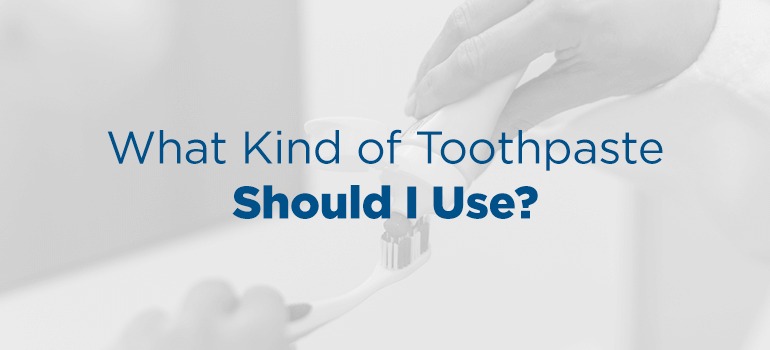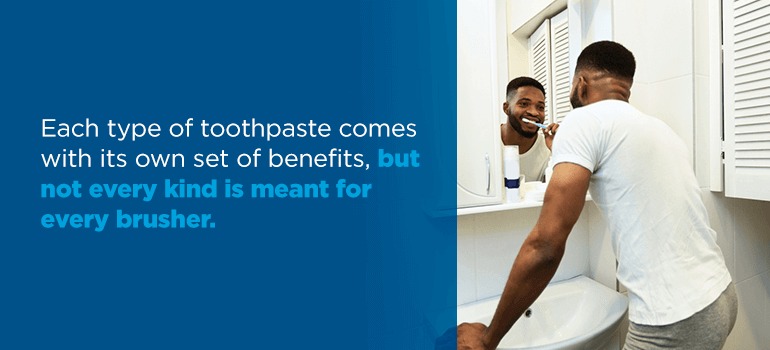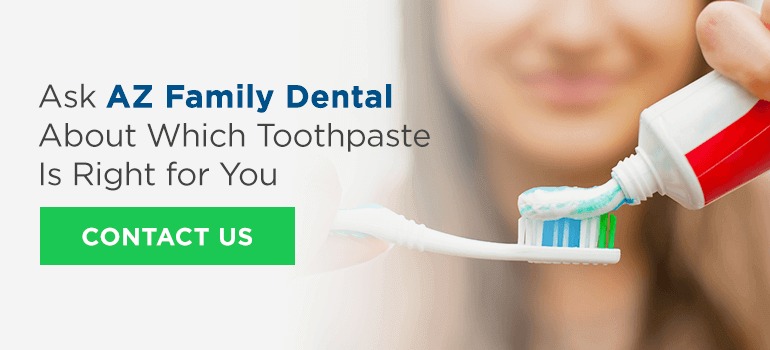
Everyone’s mouth is different, so there is no such thing as one-size-fits-all toothpaste. But what kind should you choose? You can find anything from whitening toothpaste and formulas for tooth sensitivity to tartar control options and kid’s toothpaste. Using the right toothpaste for your dental needs can boost your oral health and make your smile the brightest it can be.
To help you personalize your dental care, here is a look at the different types of toothpaste available and which kinds are the best for your teeth. After reading this toothpaste guide, you’ll be able to navigate the toothpaste aisle with confidence.
In the world of toothpaste, you have plenty of options. Take a look at the descriptions of these eight toothpaste types.
Standard toothpaste is simply intended to clean the average person’s teeth. Although we most frequently think of it as a paste, regular toothpaste can come in gel or powder form as well as a paste. In general, all toothpaste varieties contain the same basic components:
Plaque is a thin film that develops on your teeth when your saliva mixes with particles from the foods and drinks you consume. If plaque isn’t properly removed, it can build up and harden into tartar, which can lead to gum disease over time. Tartar control toothpaste is typically made with the natural cavity-fighting mineral, fluoride, and other chemical compounds to help remove excess plaque prevent potential tartar buildup.
Toothpaste for sensitive teeth is designed for those whose teeth are especially sensitive to hot or cold substances. Sensitive teeth toothpaste is different from standard toothpaste by adding potassium nitrate to its blend, which serves to reduce the painful sensations that often come with having sensitive teeth.
Because tar can develop yellowish-brown patches on teeth, those who smoke tobacco regularly tend to have stains on some or all of their teeth. For this reason, smoker’s toothpaste was specifically created for those who smoke tobacco. It normally contains special cleansing agents that help make the teeth look whiter.
Some people can develop tooth stains from routinely drinking certain beverages like coffee, tea, or soda, while others are simply naturally more susceptible to tooth stains. Whitening toothpaste can help lessen the appearance of stains or remove them altogether thanks to the special cleansers and abrasives they contain.
If you have damaged or brittle enamel, enamel repair toothpaste consists of calcium-based substances intended to replace and strengthen the tooth’s surface layer of enamel. However, the material that enamel repair toothpaste deposits on the surface of a tooth tends to be quickly and easily removed, so the long-term effects of enamel repair toothpaste are usually negligible.
Some people are sensitive to certain ingredients found in regular types of toothpaste and prefer an herbal-based alternative. Others opt for an herbal toothpaste because they simply want a more natural cleanser. If you’re considering switching to an herbal toothpaste, it’s important to note that they may not include fluoride.
To help kids get excited about brushing their teeth, many types of kid’s toothpaste come in enticing flavors such as bubblegum, watermelon, or strawberry. Kid’s toothpaste often has less abrasiveness than adult varieties since children’s teeth are more sensitive. They also contain less fluoride because kids are more likely to swallow the toothpaste as they brush. You can find kid’s toothpaste without any fluoride, too.
Each type of toothpaste comes with its own set of benefits, but not every kind is meant for every brusher. Depending on the condition of your teeth, you may need a specialized type of toothpaste.

Check out this guide on how to choose toothpaste based on your dental needs:
No matter which type of toothpaste you choose, make sure the American Dental Association (ADA) Seal of Acceptance is on its packaging. The ADA Seal denotes that the toothpaste both does what it advertises and meets the ADA criteria for effectiveness and safety. Along with the ADA Seal, look for a toothpaste that contains at least some fluoride because it can help strengthen your teeth and protect your enamel. If you would like fluoride-free toothpaste for yourself or for your kids, talk to your dentist about ways to still keep your teeth strong and healthy.
If you’re feeling uncertain about what kind of toothpaste would be best for your teeth or overwhelmed by the sheer amount of toothpaste options available to you, contact AZ Family Dental to discuss which variety would be most beneficial for you. At AZ Family Dental, we treat each of our patients like family. We love working with our fellow Glendale, AZ, community members and would be happy to help you select a toothpaste type and dental plan to enhance your oral health.
For modern dentistry done right, call AZ Family Dental at 623-777-2037 today.
